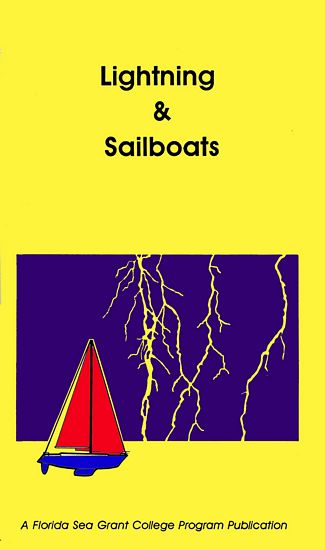
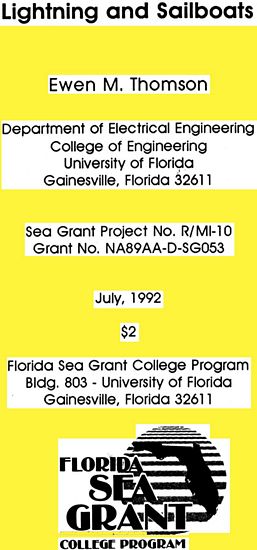


Introduction
The sight of a jagged lightning bolt licking the not-too-distant horizon
undoubtedly gives rise to concerned thoughts in the minds of many sailors. Few
actually act on their thoughts. And very few understand the phenomenon well
enough to act confidently.
Questions abound - What do I do if a lightning storm is
approaching or on me? What happens when lightning strikes a boat? Does a
lightning protection system help? But if I do install a lightning
protection system, won't it attract lightning? How do I install a
protection system anyway? Other questions relate to lightning itself- Does
lightning go up or down? Do the light and thunder originate at the same time?
What causes thunder? Why does lightning sometimes flicker? What dictates whether
lightning will strike an object on the ground or water?
In this Bulletin, and in the Sea Grant video
"Lightning and Sailboats Video" we attempt to answer these questions. We
describe the physics of lightning at a layman's level, discuss how a lightning
protection system is supposed to work, and explain some of the technical
details necessary for the correct installation of a protection system. A more
technically oriented paper is published in the technical literature on lightning on boats.
Thunderstorms
From the sailor's point of view, thunderstorms are best avoided. There are
several techniques that can be employed to recognize a growing storm and
track one that is moving in your direction. The thunderstorm, or cumulonimbus
cloud, is best recognized in its forming stages by its tightly packed
"cotton wool" appearance. This occurs because a tremendous
amount of energy is being released to produce powerful convection inside and
around the cloud. Of course, if the thunderstorm is forming directly
overhead the cotton wool appearance will not be visible, only a gray
overcast that slowly darkens and eventually produces torrential rain, lightning
and strong winds. The first few flashes of lightning in a
thunderstorm typically do not reach the ground and may be completely
invisible during daytime. One way to determine what is going on in the
area is with a cheap AM radio. (Note: FM radios do not work nearly as well
for lightning detection.) The characteristic crackle that we call 'static'
on an AM radio is caused by lightning. A common problem in summer is
that there are too many storms within radio range, which may be hundreds
of miles. In order to lower the sensitivity of your radio to distant
storms, tune it to a local radio station, or, if the signal is too strong,
slightly off tune. Any loud static can then be interpreted as a warning
that things are charging up. Once a thunderstorm starts
to produce lightning that hits the ground or 'ground flashes', these can
be used to locate a thunderstorm. One method is to track a collision
course using a hand bearing compass:: if the bearing to the lightning does not
change, on average, the storm is heading your way and it is time to adjust
your course. Another method that works once the thunder can be heard is to count
the time between the light and the thunder. Since the light arrives almost
instantaneously and the thunder travels at a speed of 1/5 mile/second, this time
divided by five gives the distance to the lightning. For example, if the thunder
starts 30 seconds after the lightning, the flash is 6 miles away. See Figure 1. 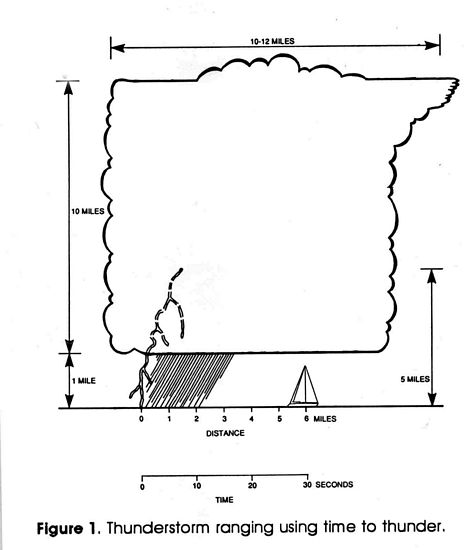 Note
that the thunderstorm is about 10 miles across and that ground flashes originate
anywhere inside the storm at a height of about 5 miles. Further, lightning
channels usually slant away from vertical and can even emerge from the side of
the storm (the classical 'bolt from the blue'). The danger to the boat is
obvious. That boaters frequently underestimate this danger is bome out by those
whose boats have been struck by lightning, a typical comment being that there
were no thunderstorms in the area just before their boats were struck. Others
signs of imminent lightning are even more obvious. St. Elmo's fire and buzzing
sounds off radio antennas arise when a boat is in the large electric field
directly below an electrifled cloud. Although lightning may not yet have begun,
its occurrence in the immediate vicinity is exceedingly probable when these
electrical phenomena are observed. Act as if your boat is about to be hit by
lightning, as described below.
Note
that the thunderstorm is about 10 miles across and that ground flashes originate
anywhere inside the storm at a height of about 5 miles. Further, lightning
channels usually slant away from vertical and can even emerge from the side of
the storm (the classical 'bolt from the blue'). The danger to the boat is
obvious. That boaters frequently underestimate this danger is bome out by those
whose boats have been struck by lightning, a typical comment being that there
were no thunderstorms in the area just before their boats were struck. Others
signs of imminent lightning are even more obvious. St. Elmo's fire and buzzing
sounds off radio antennas arise when a boat is in the large electric field
directly below an electrifled cloud. Although lightning may not yet have begun,
its occurrence in the immediate vicinity is exceedingly probable when these
electrical phenomena are observed. Act as if your boat is about to be hit by
lightning, as described below.
Lightning The only type of lightning that need concern sailors is the ground flash, since lightning that does not reach the ground does not damage boats. Ground flashes can be expected to hit from 4-20% of moored sailboats per year in Florida. Cruising sailboats typically get hit at least once in their lifetimes. The standing records for the total number of strikes to a single boat is five (in Sarasota, Florida) and the highest strike repetition rate is twice within ten seconds (in the Indian ocean). The typical ground flash starts at a height of about 5 miles above water, inside a region of the thunderstorm that is charged negatively. The path, or channel, that eventually connects this negative charge to ground begins here. As the channel extends towards ground during the 'stepped leader' phase, negative charge is funneled from the cloud into a spark channel. When the tip of the stepped leader is about 30-100 yards above ground level, another spark, this time positively charged, is launched from the ground. A massive amount of power is generated when this positively charged attachment spark and the negatively charged stepped leader connect. At this time the peak lightning current is generated, during the 'return stroke'. Although cresting at ten thousand to hundreds of thousands of amps, it only lasts for about a millionth of a second. Longer lasting currents of a few hundred to a few thousand amperes may persist for much longer times (on the short time scale of the lightning) during a 'continuing current'. These long-lasting continuing currents are responsible for large heating effects and are thought to be responsible for forest fire ignition. After a short pause, subsequent leaders may reenergize the channel, followed by more return strokes and, on occasion, continuing currents. A typical ground flash has about three leader/return stroke sequences. Lightning frequently appears to flicker because each return stroke lights up the channel, and the time between them is sufficiently long enough to be seen by the human eye.The return stroke heats up the lightning channel to a temperature about six times as hot as the sun. This causes the surrounding air literally to explode. We hear this explosion as thunder that appears to last for much longer than the lightning, which is all over in less than a second, because the lightning channel network covers several miles. The speed of sound is only about 600 knots and so thunder from more distant parts of the cloud arrives later than thunder from closer parts. The important thing is that the light and sound are generated at the same time since they are both caused by the return stroke.
Lightning
Interaction with a Sailboat
As the negatively-charged stepped leader moves downwards, it
induces a positive charge on the ground below. When the tip of the leader is
about 30-100 yards above ground level, the induced positive charge becomes so
concentrated that a new spark forms at the ground, as shown in Figure 2.  This
positively charged spark is the crucial process as far as the attachment to a
boat is concerned. If it starts at the tip of a boat mast, then lightning
strikes the mast. Unfortunately, there is no scientifically accepted technique
to prevent this spark from forming. Even if a device were effective in diverting
the attachment spark, it would not be a good idea to mount it on the masthead as
the attachment spark may start elsewhere on the boat or crew. The likelihood of
lightning attaching to the masthead is a safety feature as far as the crew is
concerned.
This
positively charged spark is the crucial process as far as the attachment to a
boat is concerned. If it starts at the tip of a boat mast, then lightning
strikes the mast. Unfortunately, there is no scientifically accepted technique
to prevent this spark from forming. Even if a device were effective in diverting
the attachment spark, it would not be a good idea to mount it on the masthead as
the attachment spark may start elsewhere on the boat or crew. The likelihood of
lightning attaching to the masthead is a safety feature as far as the crew is
concerned.
Consequently, lightning protection means minimizing the
damage caused by lightning in the event of a strike, rather than preventing a
lightning strike. In general terms, a protected boat is one in which there is a
continuous conducting path from the water to the mast tip. The current needed to
feed the attachment spark is conducted through the protectionsystem from the
water. That is, the path that the lightning takes in the boat is forced to be
that of the conductors in the protection system. If this conducting path is not
continuous, for example, in a boat which is not well grounded, there is little
difference as far as the top of the mast is concerned. The attachment spark
still begins there as this is where the positive charges have concentrated. The
difference is what happens where the conducting path, the mast, ends. Since
current cannot flow from the ground to feed the growing attachment spark, a
negative charge accumulates at the base of the mast and eventually arcs across
in the general direction of the water or a nearby conductor. (For this exercise,
crew members are conductors!) The result is an unharnessed electrical discharge
between the bottom of the mast and the water.
According to the above argument, the
likelihood that lightning will strike a boat does not depend on whether the boat
is well grounded or not. There is some support for this in the experiences of
marine surveyors. Nine marine surveyors in Florida, each of whom had surveyed
more than 200 sailboats in their career, reported that between 2% and 67% (on
average 34%) of the boats they surveyed for any reason had a lightning
protection system. Of the boats that they surveyed because of a lightning
strike, they reported that between 0% and 67% (on average 29%) had a protection
system. While the individual estimates varied widely between surveyors, there is
no support for the argument presented by some sailors that they should not
ground 'their sailboat since it will increase the chances of it being
struck by lightning.
Sideflashes
Data obtained from sailors whose boats have been struck by
lightning are consistent with the above scenario: boats that do not have a
protection system do indeed suffer more damage. The type of water, whether salt
or fresh, is also important. Damage is much more extensive for boats struck by
lightning in fresh water than for boats struck in salt water because fresh water
is a worse conductor. Consequently, it is much more difficult to design an
adequate protection system for boats in fresh water than for boats in salt
water. Figure 3 summarizes these data for a sample of 71 boats that were struck
by lightning. 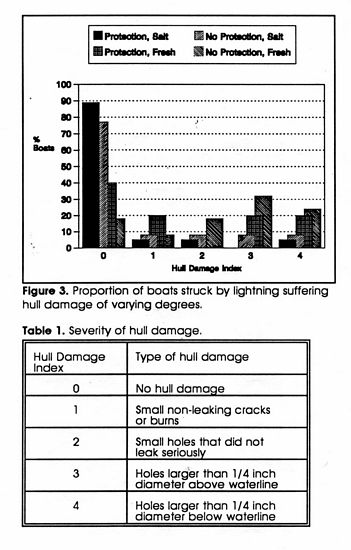 The
bars show the percentages of boats in each category that received various
magnitudes of hull damage. The four categories were boats with/without
protection systems in salt/fresh water. The damage indices indicate the severity
of hull damage as shown in Table 1.
The
bars show the percentages of boats in each category that received various
magnitudes of hull damage. The four categories were boats with/without
protection systems in salt/fresh water. The damage indices indicate the severity
of hull damage as shown in Table 1.
In boats with a hull damage of 2 or higher the
lightning had formed its own path(s) through the boat hull. If a lightning
protection system was present it malfunctioned. As the statistics show,
malfunctioning protection systems are very common in fresh water: 40% of
protected boats in fresh water experienced this effect. The most likely way that
this happened was through the formation of "sideflashes". These are
sparks that form between the lightning protection system and ungrounded
conductors or the water. Basically, in order to dissipate a lightning current in
fresh water a much more extensive underwater grounding system is needed than
that usually found in 'protected" boats. This is described in more detail
below.
Technical Aspects of the Lightning Protection System
Overview
Although lightning protection needs to be designed on a
boat-by-boat basis and ideally installed during manufacture, there are three
major considerations in a good protection system: (a) grounding, (b) bonding,
and; (e) electronics protection. The grounding system is intended to provide an
adequate conducting path from the point of lightning attachment, usually the
masthead, to a system of conductors in the water, without producing sideflashes.
The bonding system protects the crew and consists of conductors that short out
large metal fittings so that large voltages cannot develop between them.
Electronics protection limits power supply and transducer voltages through a
combination of transient protection devices and careful wiring techniques.
Grounding
The idea of the grounding system is to divert the lightning
current through a predetermined path so that it does not make its own explosive
path through fiberglass, teak, crew members, etc. Figure 4 shows what can happen
when lightning strikes an ungrounded fiberglass boat with an aluminum mast.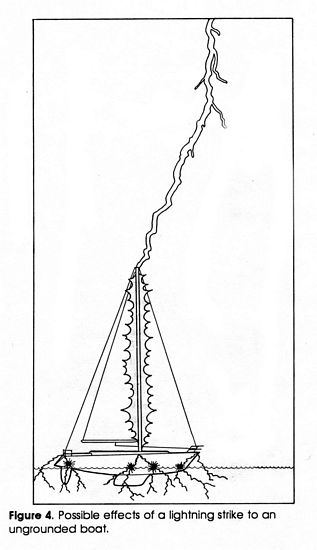 The
lightning charges all of the rigging but no conducting path exists to channel
the charge into the water. The result is destructive sparks between the lower
parts of the rigging, such as the mast base and chainplates, and the water.
Wherever these sparks travel through bad conductors (fiberglass hull, teak
bulkheads, through-hulls, porta-potties, etc.) sufficient heat is generated to
explode the impeding material into a nicely conducting plasma that is hotter
than the surface of the sun.
The
lightning charges all of the rigging but no conducting path exists to channel
the charge into the water. The result is destructive sparks between the lower
parts of the rigging, such as the mast base and chainplates, and the water.
Wherever these sparks travel through bad conductors (fiberglass hull, teak
bulkheads, through-hulls, porta-potties, etc.) sufficient heat is generated to
explode the impeding material into a nicely conducting plasma that is hotter
than the surface of the sun.
The components of the grounding system are: (i) an air
terminal at the top of the mast; (ii) downconductors, and; (iii) grounding
conductors that are immersed underwater ("ground strips" or
"ground plates"). The air terminal is the point where the lightning is
supposed to attach, the down-conductors conduct the current from the air
terminal to below the water, and the grounding conductors dissipate the current
into the water without forming any sideflashes. Usually the aluminum mast is
connected in as part of the down-conductor network.
On a sailboat with a VHF radio, the masthead VHF antenna
usually serves as a sacrificial air terminal. In fact, one of the first signs
that lightning has struck a boat is typically that shards of antenna material
are scattered around the deck. The presence of a VHF antenna or other expensive
masthead transducers makes a separate air terminal highly desirable, although
this will degrade the performance of the VBF. The top of the air terminal should
be sufficiently high that the angle from it to any other masthead object is less
than 45 degrees. That is, the air terminal provides a 'cone of protection' that
attracts lightning (or, more accurately, launches an attachment spark)
preferentially to any other object that is below a conical surface whose apex is
on the top of the air terminal and that has a 90-degree apex angle.
An aluminum mast is the preferred down conductor, being a
much better conductor than stainless stays. If the mast base is on top of the
cabin, a downconductor is needed to connect the mast base to the ground strips.
Use at least #4 gauge copper with preferably bimetallic copper/stainless
connections to prevent galvanic corrosion. Alternatively, make a strong
mechanical connection and additionally braze or solder, to improve the
electrical contact and lessen the chance of contact corrosion, then paint with
an insulating coating. A keel-stepped mast similarly needs to be connected to
the keelbolts with at least #4 gauge copper.
The ground strips in contact with the water should be
connected to the down-conductors with care to avoid galvanic corrosion. In salt
water a single grounding conductor of a square foot or more in area is usually
enough. In this respect, a lead keel connected to the down-conductor via the
keel bolts is adequate. If the lead is either painted or encapsulated in
fiberglass, minor repairs may be needed after a lightning strike. However, the
paint or fiberglass does not seriously compromise the ballast lead as a
lightning ground. Note that this system does not work in river mouths where
there may be a less dense layer of fresh water riding on top of a salt water
"wedge". The situation in fresh water is much more complicated as the
voltages involved during a lightning strike are about a thousand times larger
than those that occur on a boat in salt water. A good start is to lay a flat or
'D' cross section strip of 3/4" x 1/8 ' stainless or brass along the
outside of the stem of the boat. Connect this to the forestay, mast base, and
backstay with #4 gauge vertical copper down-conductors. However, this is not
usually enough. In addition, extra ground strips are needed just outside the
hull close to metal fittings such as gas tanks, metal-cored plumbing pipes,
wiring, etc. Connect these to the grounding system using near vertical
down-conductors. Under no event should these down-conductors run close to the
hull except where they penetrate the hull to connect to the grounding strip:
otherwise the conductor may cause a sideflash through the hull. The engine,
propeller shaft, and propeller should be regarded as part of the grounding
system and tied in appropriately.
The manner in which a correctly grounded.boat reacts to a
lightning strike is illustrated in Figure 5. 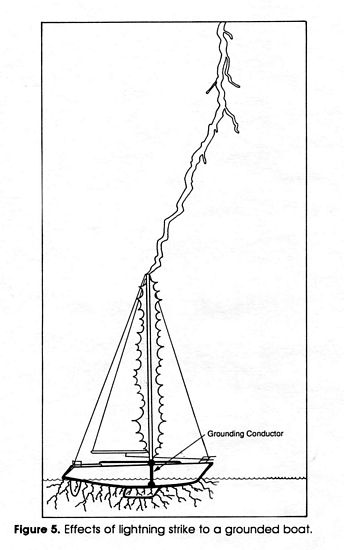 The
lightning charge that flows onto the rigging does not accumulate to the point
where it forms destructive sparks, as was the case for an ungrounded boat.
Instead, it is discharged into the water over a wide region. The more evenly the
charge can be discharged into the water, the less likely it is that a sideflash
will occur through the boat hull.
The
lightning charge that flows onto the rigging does not accumulate to the point
where it forms destructive sparks, as was the case for an ungrounded boat.
Instead, it is discharged into the water over a wide region. The more evenly the
charge can be discharged into the water, the less likely it is that a sideflash
will occur through the boat hull.
Bonding
The difference between the grounding system and the
bonding system is only one of degree since both are interconnected and both will
conduct current during a lightning strike. Whereas the grounding system is
designed to handle the full lightning current, the bonding system consists of
mainly horizontal connections between metal fittings to short out any voltages
that might otherwise develop. Bonding is a measure that is intended to protect
the crew and enable them to work the boat without getting shocks. This can occur
from nearby lightning as well as from direct strikes. Smaller gauge conductors
than the grounding system are adequate in the bonding system, down to #8 gauge
copper. As with the grounding down-conductor connections, all bonding
connections should be made to minimize galvanic corrosion. Metallic fittings
that should be bonded to the grounding system, using horizontal connections as
much as possible and avoiding the hull, are toe rails, chain plates, steering
wheels, motor controls, bow and stern pulpits, antenna bases, the ground wire
for the electronics, etc.
The illustrations in Figure 6 show what happens on board a
bonded (bottom) and unbonded (top) boat during a lightning strike. On the
unbonded boat large voltages develop between the mast, chainplates, forestay,
backstay, wheel, rudder post, toe rails, electronics, wiring, metal reinforcing
in plumbing fixtures, engine, etc. These make working the boat extremely
hazardous, even if lightning is not striking the boat directly. On the bonded
boat these voltages are shorted out by bonding conductors. Note, however, that
the large magnetic fields associated with a direct lightning strike make the
concept of an electrical "short" a misnomer. Appreciable voltages can
develop between the ends of long conductors even if the conductors are connected
together at their other end. The helm is a particularly dangerous place owing to
its proximity to the engine controls, boom, rudder post and backstay. The
helmsman in Figure 6 (bottom) would not be smiling if he had one hand on the
tiller and the other on the engine controls, for example. (Note that he is
steering with one hand in his pocket to minimize the risk of making a connection
between two conductors at different voltages. This is not as safe as throwing
over the anchor and going below!) For stations such as the helm that are usually
manned, it is crucial that the bonding conductors should be kept as short and
straight as possible.

Electronics
Electronics-killing overvoltages may be introduced through the DC power wires,
antenna input, or any other external connection such as a lead to a transducer.
Electronics on a small sailboat that are struck by lightning are particularly
difficult to protect since it is impossible to divert the lightning current any
appreciable distance away from" the electronics. This difficulty, and the
pervasive nature of electronics damage, is illustrated in Figure 7 that shows
the percentages of boats with electronics damage of different magnitudes.
In this case there is less of a distinction between boats
struck in fresh water versus salt water as there was for hull damage, but the
same trend is evident: boats with protection systems in salt water fare best and
boats with no protection systems in fresh water fare worst. More notably, 96% of
all boats sustained damage to at least some electronics items. Apparently a
lightning protection system, as installed on the boats in the survey, does not
necessarily save the electronics. Note that for these boats "lightning
protection" merely meant that the boat was grounded, not necessarily bonded
with transient protection devices, as explained below.
In order to protect electronics, more is needed than merely
diverting the current to ground (water) without its blowing a hole in the hull.
Due to the low voltages typically used in modern marine electronics, just a few
extra volts is enough to cause extensive damage. However, techniques that are
used to protect computers, cable TV and radio equipment on land can also be used
in shipboard DC and AC equipment. Some devices are readily available from
electronics stores. Radio antennas can be protected using lightning arrestor
hardware designed for cable TV. Connect the "ground' connection to the
lightning grounding network. AC transient protection outlets or plug-in metal
oxide varistors (MOV) work also on boats but need to have their ground
connections connected to the shore ground wire. Ideally this ground should also
be connected to the lightning protection ground but this circuit arrangement can
cause ground current problems in marinas. As for protection of DC electronics,
which are probably the most important, transient protection devices are
available to clamp voltages at the point where each piece of equipment is
connected to the DC supply. These are available from companies such as General
Electric or from mail order electronics distributors. They can be found under
the generic name "Transient Suppressors" and are of various types:
metal oxide varistor, silicon avalanche diode, and surge suppressor zener diode.
It is important to locate this protection device immediately next to the
equipment and each piece of equipment should have its own device. The
overvoltages that appear at DC inputs can be reduced by using twisted-pair
wiring in wiring harnesses, ideally with a conducting sheath that is connected
to the bonding system. The overall philosophy here is to minimize the spacing
between positive and negative DC lines. If a main control center exists,
surround it with a conducting enclosure that is connected to the bonding system.
Through-hull transducers are especially vulnerable. Due to the typically
vertical alignment of the cables connecting these to their main electronics,
they should be regarded as being part of the lightning grounding system. Since
the wires used in these cables are of an insufficient thickness to withstand a
lightning strike, a #4 gauge copper wire should be placed parallel to any cable
that leads to a through-hull transducer. The top of this copper wire should be
reconnected to the lightning grounding system and the bottom to a ground strip
close to the underwater transducer on the outside of the hull.
As with all aspects of lightning protection, 100%
effectiveness cannot be guaranteed, even if all the above measures are taken for
electronics systems. Disconnecting equipment in advance of a storm helps isolate
it from voltages induced by lightning, and the larger the lead separation the
better. Use disconnects in preference to knife switches, and these in preference
to switch panels.
Personal Safety
Consider the worst case scenario for a lightning strike to a sailboat - a small
boat in fresh water. If the boat has been provided with a well-built protection
system it is still an exceedingly hazardous situation. If lightning protection
does not exist, the situation is life threatening. In both cases, the areas to
avoid are close to the waterline and close to large metal fitting. In the
unprotected boat, an additional -danger zone is beneath the mast or boom. Even
in the unprotected boat, it is unwise to get in the water, as electrocution is
highly probable if lightning strikes nearby. In fact, there is no safe place on
an unprotected small sailboat, and in a protected boat only places of relative
safety. There is, however, one place that is more hazardous than a small
unprotected sailboat, that is a small unprotected boat without a mast. Every
year there are multiple deaths of boaters in open boats caused by lightning
strikes, but very few reports of sailors in sailboats killed by lightning.
The above general rules also apply to larger sailboats. These are generally
safer, if protected, since it is possible to get away from the waterline and
large metal objects, and yet still stay dry inside the cabin. As far as
unharnessed electricity is concerned, a dry human body is much less attractive
than a wet one.
Conclusions
Lightning protection on a sailboat means diverting the lightning current into
the water without its causing any hull damage, personal injury, or electronics
damage. This involves providing a continuous, mainly vertical, conducting path
from above any vulnerable masthead transducers to grounding conductors immersed
in the water (the grounding system) and a network of mainly horizontal
interconnected conductors attached to large metal fittings, including the
grounding system (the bonding system). Transient suppressors are needed on each
piece of electronics equipment, and wiring should all be twisted pair for
protection of electronics.
| Florida Sea Grant College is supported by award of the Office of Sea Grant, National Oceanic and Atmospheric Administration, U.S. Department of Commerce, grant number NA 89 AA-D-SGO53, under provisions of the National Sea Grant College and Programs Act of 1966. This information is published by the Sea Grant Extension Program which functions as a component of the Florida Cooperative Extension Service, John T. Woeste, Dean, in conducting Cooperative Extension work in Agriculture, Home Economics, and Marine Sciences, State of Florida, U.S. Department of Agriculture, U.S. Department of Commerce, and Boards of County Commissioners, cooperating. Printed and distributed in furtherance of the Acts of Congress of May 8 and June 14, 1914. The Florida Sea Grant College is an Equal Opportunity-Affirmative Action employer authorized to provide research, educational information and other services only to individuals and institutions that function without regard to race, color, sex, age, handicap or national origin. |
Source: Ewen M Thompson. Lightning and Boats, University of Florida Sea Grant. www.thomson.ece.ufl.edu/lightning